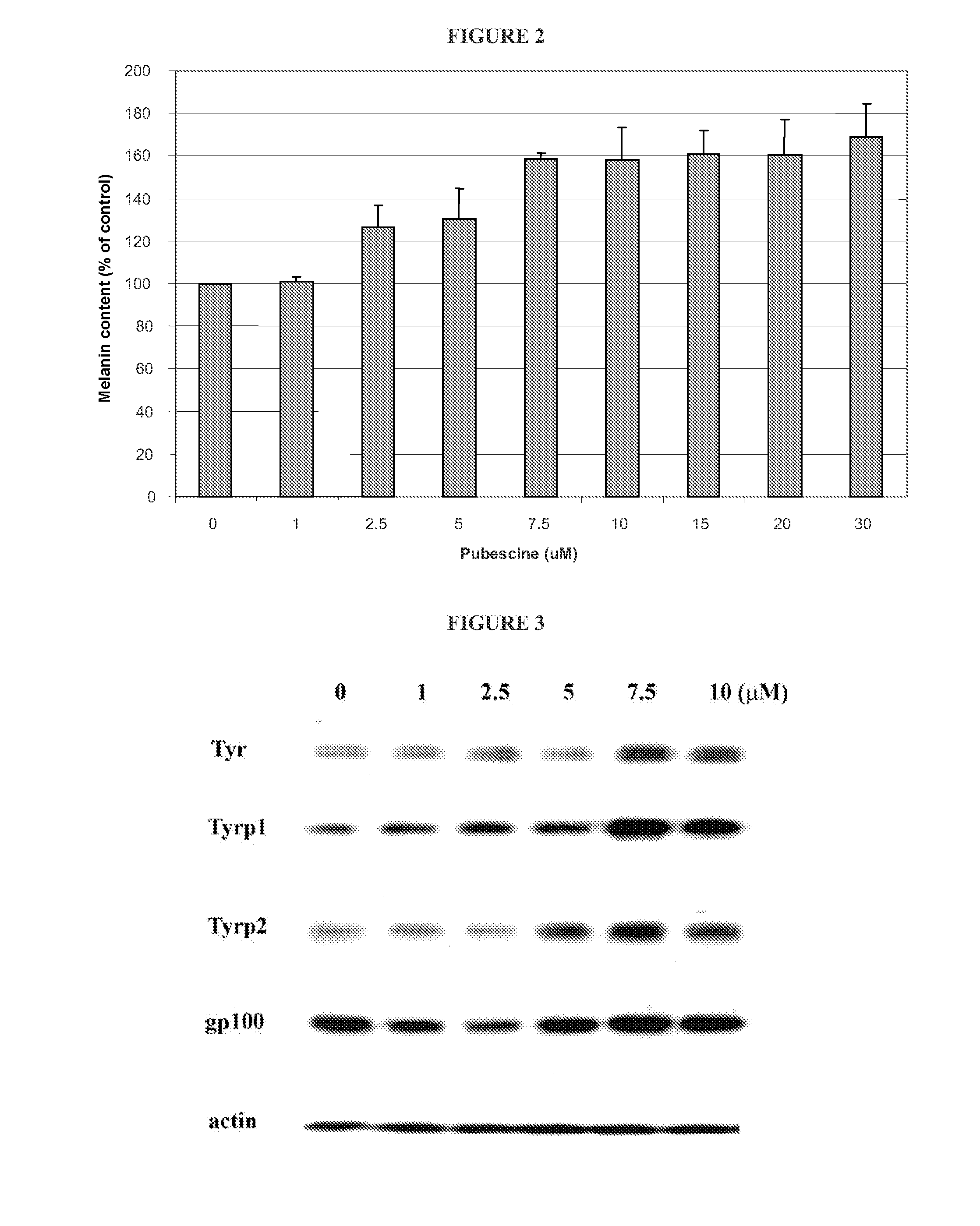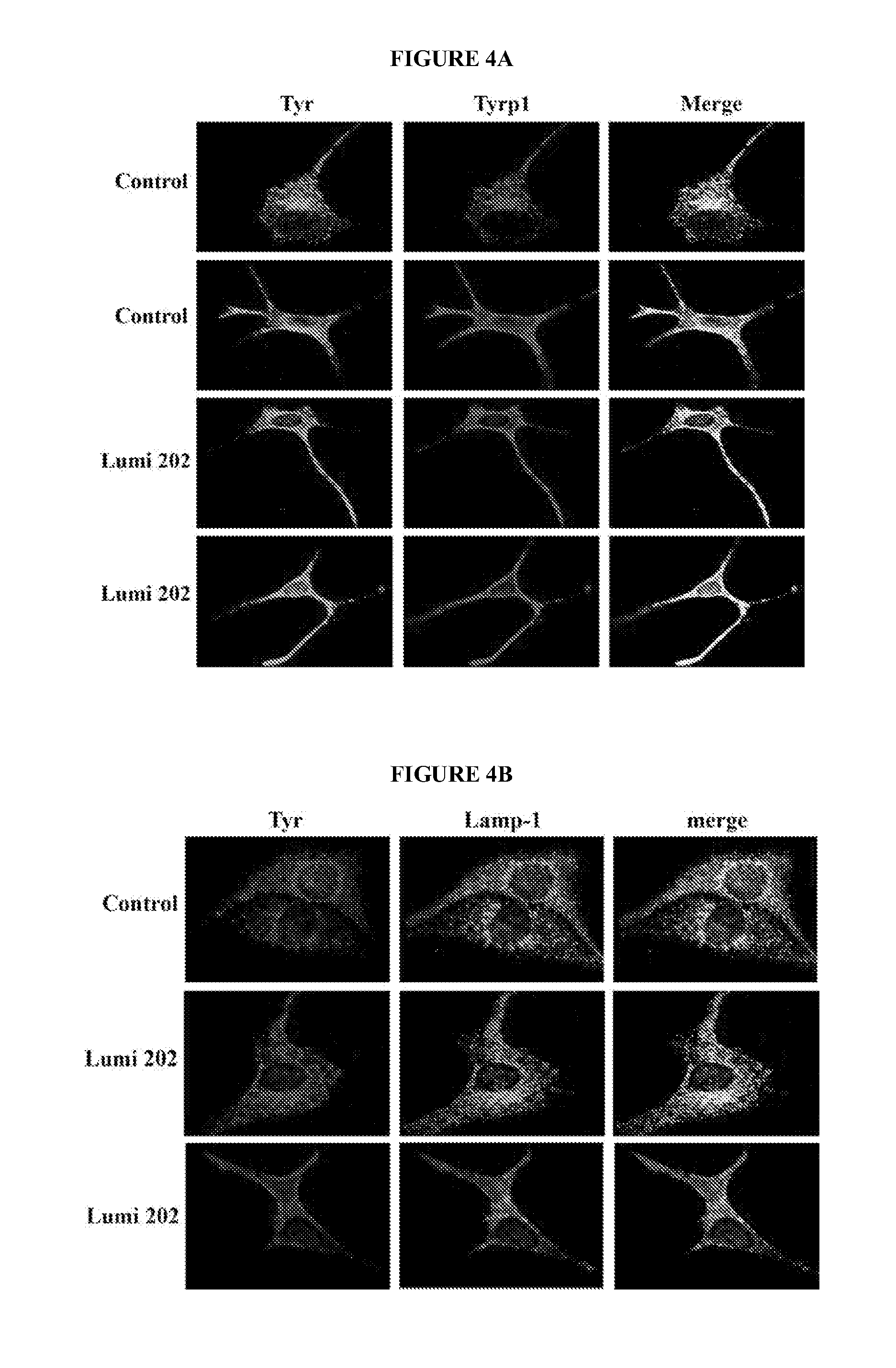Indole alkaloid compounds as melanogenesis promoters and uses thereof
a technology of indole alkaloid compounds and promoters, which is applied in the direction of biocide, plant/algae/fungi/lichens ingredients, biocides, etc., can solve the problems of albinism, none of these indole alkaloids have been reported to be useful in increasing melanin synthesis, etc., to stimulate or promote (rather than inhibit) melanogenesis, increase the content of melanin, and stimulate or promote melano
- Summary
- Abstract
- Description
- Claims
- Application Information
AI Technical Summary
Benefits of technology
Problems solved by technology
Method used
Image
Examples
example 1
Screening of Compounds in Cultured Murine Melanocytes
[0365]The Spectrum Collection library consisting of 2000 drug compounds or natural products was screened to identify novel pigmentation inhibitors or stimulators in cultured murine melanocytes (melan-a). Compounds were dissolved in dimethylsulfoxide (DMSO) to a final concentration of 10 mM. Screening was performed with cultured melanocytes in 24-well plates followed by melanin assay (see below). A minimum change of 50% in melanin formation was established as significant for a pigmentation inhibitor or stimulator. DMSO was used as a negative control and the widely used depigmenting agent, hydroquinone, was used as a positive control on every plate. Primary screening was performed at a final concentration of 1 μM and potential candidates from the primary screening were reconfirmed in duplicate at final concentrations of 1 and 5 μM.
[0366]Melan-a cells were plated at 5×104 cells per well in 1 ml of culture media in 24-well plates the ...
example 2
[0368]For the primary and secondary screening, cells were harvested and dissolved in 200 μl of 2N NaOH in 20% DMSO at 70° C. A 180-μl aliquot of the resulting solution was measured for absorbance at 490 nm.
[0369]Cells are harvested in extraction buffer (1% Triton X-100, 50 mM Tris, 2 mM EDTA, 150 mM NaCl, pH 7.5) containing a complete protease inhibitor cocktail (Roche). The lysates were centrifuged at 14,000 rpm for 10 minutes at 4° C. BCA protein assay kit (Pierce) was used to measure the protein concentrations of the supernatants, and bovine serum albumin was used as a standard. The remaining pellets were incubated with 100 μl ethanol-ether (1:1) for 10 minutes at room temperature. After removing the ethanol-ether, the pellets were dissolved in 200 μl of 2N NaOH in 20% DMSO at 70° C. A 180-μl aliquot of the resulting solution was measured for absorbance at 490 nm. The melanin contents were normalized to the total amount of protein.
[0370]The compounds, their structure...
example 3
MelanoDerm™ Pigmentation Assay
[0372]The compounds of the invention were tested in the MelanoDerm™ pigmentation assay, to confirm and demonstrate their activity as modulators or promoters in a setting that replicates in vivo conditions. MelanoDerm™, made by MatTek Corp., is a viable reconstituted three-dimensional human skin equivalent containing normal melanocytes and keratinocytes that are derived from African-American (MEL-B), Asian (MEL-A) or Caucasian (MEL-C) donors. Both MEL-A and MEL-B tissues were used in the current study, and they were maintained in the NMM-113 medium as recommended by the manufacturer.
[0373]Pubescine (from Sigma) was dissolved in 30% ethanol: 70% propylene glycol to a final concentration of 1.0 mM (equal to 356.6 μg / ml), and this was maintained constant and used on all samples tested. A 25 μl of its aliquot was applied topically to the MelanoDerm™ tissue (MEL-B) on Days 0, 1, 3, 6, 8 and 10. The MelanoDerm™ tissues were fed every other day with 5 ml fresh ...
PUM
| Property | Measurement | Unit |
|---|---|---|
| concentration | aaaaa | aaaaa |
| concentration | aaaaa | aaaaa |
| concentration | aaaaa | aaaaa |
Abstract
Description
Claims
Application Information
 Login to View More
Login to View More - R&D
- Intellectual Property
- Life Sciences
- Materials
- Tech Scout
- Unparalleled Data Quality
- Higher Quality Content
- 60% Fewer Hallucinations
Browse by: Latest US Patents, China's latest patents, Technical Efficacy Thesaurus, Application Domain, Technology Topic, Popular Technical Reports.
© 2025 PatSnap. All rights reserved.Legal|Privacy policy|Modern Slavery Act Transparency Statement|Sitemap|About US| Contact US: help@patsnap.com



